AudioQuest William Tell ZERO Speaker Cables and Water Interconnects by Greg Simmons
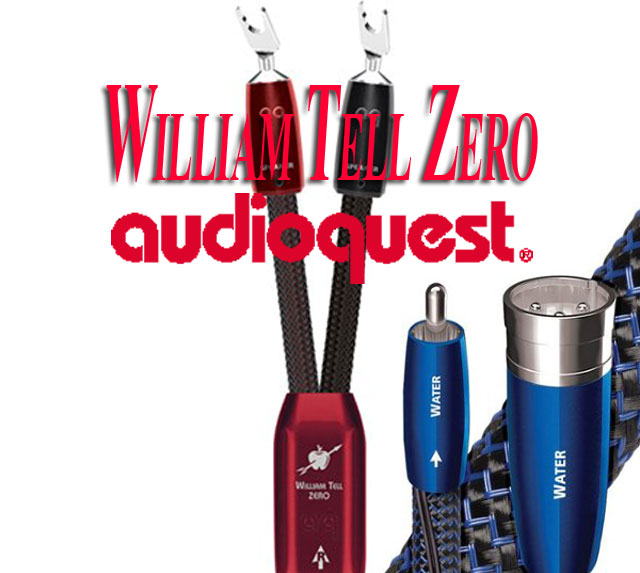
A Preamble Note to Readers
 Friends – As of this writing, all Western Pennsylvania is under a “Stay-At-Home” order during the second week of May. It’s almost certain you are experiencing something similar wherever you live. I’m fortunate to be employed in a business that’s been designated as an essential service and to have the ability to work from home, but many of my friends, and over sixteen million other people over the past three weeks, have not been so fortunate. Lord only knows how large that figure will have grown by the time this gets published. It may seem frivolous to be writing about expensive audio equipment when millions of people may shortly be worrying about how to pay their mortgages and rent, or worse, falling ill, but we’re all going to need diversions too. Better to carry on doing normal things like writing reviews than dwelling on the pain the country is experiencing. The health, economic, and social consequences of the Covid-19 virus are going to be deep and widespread, and it will almost certainly get worse before it gets better. You may not be affected today, but you could be tomorrow. Please remember your neighbors, be cognizant that we’re all in this together, and support each other as best we can in these extraordinary times.
Friends – As of this writing, all Western Pennsylvania is under a “Stay-At-Home” order during the second week of May. It’s almost certain you are experiencing something similar wherever you live. I’m fortunate to be employed in a business that’s been designated as an essential service and to have the ability to work from home, but many of my friends, and over sixteen million other people over the past three weeks, have not been so fortunate. Lord only knows how large that figure will have grown by the time this gets published. It may seem frivolous to be writing about expensive audio equipment when millions of people may shortly be worrying about how to pay their mortgages and rent, or worse, falling ill, but we’re all going to need diversions too. Better to carry on doing normal things like writing reviews than dwelling on the pain the country is experiencing. The health, economic, and social consequences of the Covid-19 virus are going to be deep and widespread, and it will almost certainly get worse before it gets better. You may not be affected today, but you could be tomorrow. Please remember your neighbors, be cognizant that we’re all in this together, and support each other as best we can in these extraordinary times.
Pax
Two Jackasses Experiment with Supposedly Better Cables
Having said that, allow me to share a colorful scene from the carefree days of my reckless, misspent youth. As a college freshman, way back in the fall of 1987, my roommate and I lived in a wreck of a room in a dormitory cellar. We had a piranha that ate live goldfish – always a crowd pleaser – and the room was often littered with electric guitars, my roommate’s girlfriends, and beer cans. The place stank of cigarettes, patchouli, and weed, especially that September as we celebrated the life and music of Peter Tosh. (We had nothing on the green cloud pouring from the room of the two Gambian gentlemen upstairs. Those guys took Tosh’s death really hard.)
In socially conservative West Virginia, we were somewhat of a lifestyle freak show. I favored long hair and tie-dyed T-shirts while my roommate had a skateboard and two-tone Mohawk. People who didn’t understand the difference between Punks and Deadheads generically called us “the hippies,” but we had a hell of a lot more fun than many of our more restrained peers. There were four guys down the hall who spent every Saturday night playing pinochle. To this day, I have difficulty imagining a lamer way to get through college. We, on the other hand, would have a few beers then take turns rolling each other down the hallway, chest down on a skateboard wearing a football helmet, bowling for overturned garbage cans.
I said fun, not smart.
 The other thing we had, besides frequent concussions, when most of our peers were listening to boom boxes or Walkmans, was a semi-decent stereo, at least by dormitory standards. There was an Onkyo receiver and a pair of large-ish Jenson speakers, with some long-forgotten cassette deck and CD player as sources. It was all strung together with those freebie interconnects that came with every piece of audio equipment in those days – red and white plastic on the ends, gray in the middle – and of course, lamp cord for speaker wire. Heavy rotation included an incongruous mix of the Grateful Dead and Black Flag. I’m sure it didn’t sound nearly as impressive as we thought it did, but it was loud! When we listened to music so did our neighbors. We were confident our stereo was awesome because all the tweeters worked.
The other thing we had, besides frequent concussions, when most of our peers were listening to boom boxes or Walkmans, was a semi-decent stereo, at least by dormitory standards. There was an Onkyo receiver and a pair of large-ish Jenson speakers, with some long-forgotten cassette deck and CD player as sources. It was all strung together with those freebie interconnects that came with every piece of audio equipment in those days – red and white plastic on the ends, gray in the middle – and of course, lamp cord for speaker wire. Heavy rotation included an incongruous mix of the Grateful Dead and Black Flag. I’m sure it didn’t sound nearly as impressive as we thought it did, but it was loud! When we listened to music so did our neighbors. We were confident our stereo was awesome because all the tweeters worked.
And here’s the part about the cables. When we got back from Christmas break that year, my roommate brought some new speaker wires made by a company whose name started with M that went out of business last year. The cables were thicker than lamp cord, but the real kicker was the price. Those speaker cables cost *GASP* two whole dollars a foot! (TWO WHOLE DOLLARS!!!) This at a time when one hundred feet of lamp cord cost around five bucks. I’m not sure what possessed him to buy this stuff, since all the equipment was mine, but we hooked it up and turned the music back on. Neither of us could tell the difference. Believe me, it would not be the last time someone wasted forty bucks on a useless audio accessory.
If the whole scene sounds like a collegiate dumpster fire, you are absolutely right. But, believe it or not, we did have textbooks, and we made it to most of our classes, though anything starting before noon was a crap shoot. It was also not unheard of to show up to a 4PM Friday afternoon class with a can of Coke half-filled with Captain Morgan’s. After all, what kind of inconsiderate, pencil-neck academic schedules a lab at 4PM on a Friday afternoon? (It was the Spanish professor!!!) Both of us miraculously managed to pass all our subjects.
When the school year was over, my roommate went home with his wires and piranha, and I went back to my parent’s house and re-installed the lamp cord. Having proven to myself that cables didn’t make a damned bit of difference, I drove speakers through that stuff for the next fifteen years.
If you’d told me in 1987 that someday I’d be listening to and appreciating the performance of a set of cables that cost close to what I paid for my amplifier, I’d have told you to put down the pipe (or at least pass it over). Then again, if you’d told me in 1987 that thirty-three years later I’d be listening almost exclusively to vinyl again I’d have laughed at you. Such is life.
We did have an awful lot of fun that year, though I don’t advise shit-faced headfirst bowling for garbage cans to anyone.
AudioQuest
AudioQuest is one of the longer-lived hi-fi equipment manufacturers operating in the United States. They’ve been in continual operation since 1980 under founder Bill Low, who started out making improved cables for friends then built the company around those efforts. In the subsequent forty-years, AQ has found success by sticking to its core business – cables – and resisting the impulse to branch into other equipment unless they complimented that primary product. There have been a few tangential efforts – tonearms and phono cartridges spring to mind – and their recent and well-received Niagara line of power conditioners, but wires have remained the core product. Their company motto is “Do No Harm” which applied to cables means getting the signal from one piece of equipment to the next with no degradation.
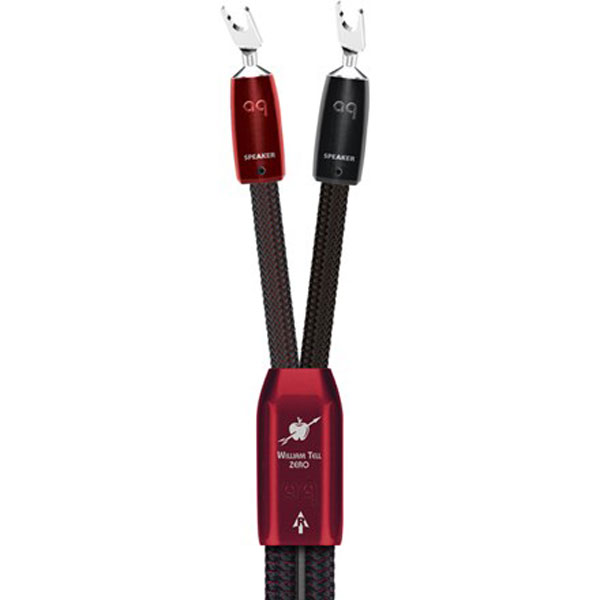
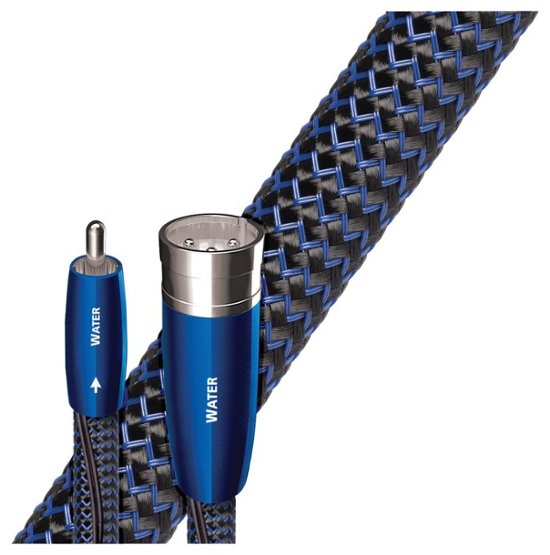
The Wires
Both wires here for review – the William Tell ZERO speaker cables and the Water interconnects – have some common material elements. Both use AudioQuest’s Solid Perfect-Surface Copper+ (PSC+), which AQ claims reduces transmission distortion, eliminates harshness and improves detail retrieval. They also include cable insulation that eliminates – to the greatest extent possible – the effects of Radio Frequency Interference (RFI), as well as AQ’s proprietary carbon-based linearized Noise Dissipation System (NDS), which AQ claims transforms excess line noise into dissipated heat, allowing a purer signal to transmit to the speakers.
“Dissipating heat” calls to mind the huge heat sinks on amplifiers that can become uncomfortably warm to the touch. No such phenomenon was observed with these cables.
 The most visible technical feature of both these cables is AudioQuest’s patented 72V Dielectric-Bias System – those little black battery packs attached to the source-end of the cables. At the risk of making an ass of myself, ala former Alaska Senator Ted Stevens, the guy who described the internet as a “series of tubes,” the best analogy I could think of is a pipe that’s leaching contaminants. If the audio signal is water, the goal is for all the water to reach the end of the pipe as clean as it entered. If lead or some other unhealthy substance from the pipe or its surrounding environment leaches into the water along the way, that water is now contaminated and the quality at the tap is …well… you might not want to drink it. Applied to cables: the voltage from the DBS unit polarizes the insulation – AQ calls it “biasing” – allowing the signal to pass through the wires with less energy siphoned into and back out of the dielectric material, an interaction that AQ claims can cause a phase shift in the signal. According to their literature this results in a more intact, uncontaminated signal that’s audible as higher dynamic contrast and quieter backgrounds. The packs have a small button that lights an LED, making it easy to tell when it’s time for a fresh battery.
The most visible technical feature of both these cables is AudioQuest’s patented 72V Dielectric-Bias System – those little black battery packs attached to the source-end of the cables. At the risk of making an ass of myself, ala former Alaska Senator Ted Stevens, the guy who described the internet as a “series of tubes,” the best analogy I could think of is a pipe that’s leaching contaminants. If the audio signal is water, the goal is for all the water to reach the end of the pipe as clean as it entered. If lead or some other unhealthy substance from the pipe or its surrounding environment leaches into the water along the way, that water is now contaminated and the quality at the tap is …well… you might not want to drink it. Applied to cables: the voltage from the DBS unit polarizes the insulation – AQ calls it “biasing” – allowing the signal to pass through the wires with less energy siphoned into and back out of the dielectric material, an interaction that AQ claims can cause a phase shift in the signal. According to their literature this results in a more intact, uncontaminated signal that’s audible as higher dynamic contrast and quieter backgrounds. The packs have a small button that lights an LED, making it easy to tell when it’s time for a fresh battery.
Finally, the William Tell ZERO speaker cables also include AQ’s ZERO technology, which is claimed to further overcome the characteristic impedance of the cable by more thoroughly isolating the positive and negative conductors from each other by more extensive shielding.
AudioQuest offers a lot of technical explanations both in its product copy and in several technical white papers they have posted on their website. Trying to summarize all of it here would be a sixty-page, heavily plagiarized tome, but I do recommend taking a look at their website. The company is unusually transparent about what they’re trying to accomplish and how they do it.
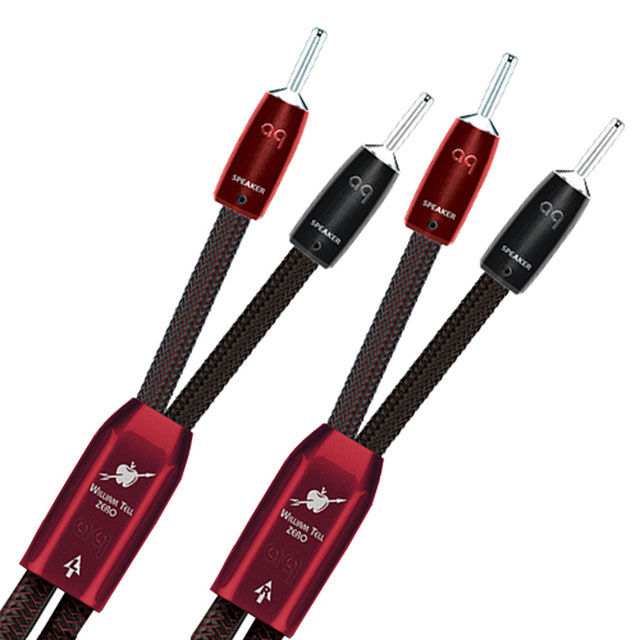
AudioQuest William Tell ZERO Speaker Cables
AudioQuest’s “Folk Hero” series is their second-tier speaker cables and a short step below the top-of-the-line “Mythical Creatures” offerings, and are said to offer a great deal of the Creatures’ performance at a lower – though by no means inexpensive – price point. The William Tell ZERO cables incorporate most of the Creature’s feature set, albeit with slightly lighter gauge – though still quite heavy – solid conductor wire. This is a stout, stiff pair of wires.
This particular pair of speaker cables is eight feet long, terminated with silver-plated copper spades protruding from dark red connection bodies. They’re wrapped in a functional black cloth with red thread outer covering. Both ends, just before the speaker terminations, have a matching dark-red knob, presumably to prevent the two strands from pulling themselves apart, and also to provide a place to connect the DBS unit to the cable insulation.

AudioQuest Water Interconnects
The Water Interconnects are the entry point into AQ’s range topping “Elements” series which also includes the Earth, Wind, and Fire cables (they have to have done that on purpose), as well as the premium Wild Blue Yonder and the company’s top statement interconnect, the WEL Signature.
These cables share many features with the William Tell speaker cables – the PSC+ copper, the carbon-based insulation technology, and the DBS system – but they also add Polyethylene air tube insulation, favored because air absorbs very little energy from the passing signal. This is not the first cable I’ve seen with an air dielectric, though these cables are significantly more robust than a pair I reviewed a few years ago from another manufacturer. Combined with the DBS system, it’s sort of a “belt-and-suspenders” approach to noise reduction. The AQ RCA jacks – copper with silver-plated male bits – are cold-welded and painted blue. The insulation is black with blue thread accents. The Water interconnect is also a pretty stiff cable, though easy enough to navigate through the equipment rack.
Both the Water and the William Tell ZEROs are very well constructed with excellent fit and finish on all the parts, which should be expected at these price points. All of the cables also arrive in a semi-rigid case, which is nice to have if you ever have to store them, and far better than the tangled Cable Medusa in a large cardboard box that many people have lying around the house somewhere (I have two).
What Do They Do?
 Anyone making a significant investment in new cables is generally trying to achieve the same few things: more detail, improved extension, better transparency, and a general overall improvement in sound quality. Good cables can assist with all of those things, but it’s important to keep expectations in check. Cables certainly make a difference – sometimes a significant difference – but they’re not going to wring miracles out your equipment. If you throw a set of $3000 speaker cables onto your sixty-year-old pair of AR-3s expecting them to suddenly sound like a pair of Wilson Master Chronosonics, you’re going to be disappointed. The key is to have reasonable expectations.
Anyone making a significant investment in new cables is generally trying to achieve the same few things: more detail, improved extension, better transparency, and a general overall improvement in sound quality. Good cables can assist with all of those things, but it’s important to keep expectations in check. Cables certainly make a difference – sometimes a significant difference – but they’re not going to wring miracles out your equipment. If you throw a set of $3000 speaker cables onto your sixty-year-old pair of AR-3s expecting them to suddenly sound like a pair of Wilson Master Chronosonics, you’re going to be disappointed. The key is to have reasonable expectations.
In that vein, I’ll begin with what the AudioQuest cables don’t do. I have five core pieces of equipment, plus a step-up transformer and three turntables, all set up and running. The tangle of interconnects, power cords, and speaker cables linking all that stuff together looks a bit like an overgrown wisteria vine, with plenty of opportunities for crossed wires to behave badly. Installed between my phono-stage, pre-amp, power amp, and then out to the speakers, the AudioQuest cables presented no unwanted noise, or any noise at all for that matter. In an all point-to-point wired tube system that alone is a success.
Installing the William Tell speaker cables proved to offer the most noticeable and immediate change. After letting them run in or a few days before doing any serious listening, the improvement in clarity and soundstage depth was pretty obvious. Bass had better pitch definition, mids were more liquid and more highly resolved, and the high treble, where that sense of air and space lives, was enhanced. These were easily audible improvements.
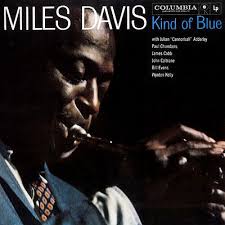 Adding the Water interconnects took it all a little further, though more subtly than the speaker cables by themselves. Where all the musical components – the musicians, the venue, and the music – were there with the speaker cables alone, the interconnects focused the clarity and enhanced the realism of those individual components by adding some semblance of three-dimensional physical existence. Deep bass backup vocals sounded like they were coming from the singer’s chest, and acoustic guitars had stronger texture and body. Ron Carter’s plucked bass during the intro to “So What?” – the opener to Miles Davis’ ubiquitous “Kind of Blue” – sounded more like a big, resonant wooden chamber and it was placed significantly further into the soundstage. Depth of field, on any recording where this effect is audible, was enhanced.
Adding the Water interconnects took it all a little further, though more subtly than the speaker cables by themselves. Where all the musical components – the musicians, the venue, and the music – were there with the speaker cables alone, the interconnects focused the clarity and enhanced the realism of those individual components by adding some semblance of three-dimensional physical existence. Deep bass backup vocals sounded like they were coming from the singer’s chest, and acoustic guitars had stronger texture and body. Ron Carter’s plucked bass during the intro to “So What?” – the opener to Miles Davis’ ubiquitous “Kind of Blue” – sounded more like a big, resonant wooden chamber and it was placed significantly further into the soundstage. Depth of field, on any recording where this effect is audible, was enhanced.
Now, these improvements are not the difference between pitch-black midnight and midday sunshine. The changes are far more nuanced than that. Searching for a metaphor here: it’s the equivalent of manually fine-tuning an auto-focus shot on a camera lens. The autofocus shows everything in the picture, but with the adjusted focus you can see it more clearly and in greater detail. Applied to a music signal, the same type of effect was audible with these cables installed. A few of my friends who’ve heard my system many times – yes, they snuck over during the quarantine – also heard the improvements, so it wasn’t just me. My dad, on the other hand, told me I was crazy, but his hearing is rapidly becoming Beethoven-esque, so he may not have been the best choice for an audition.
Another unexpected bonus: with a cleaner signal, and complementing some recently installed Mundorf caps, I found I was able to switch the amplifier from Ultra-Linear mode (130 watts) down to Triode mode (about 70 watts) where it sounds far more natural, and it now plays at lower volume with no degradation in bass strength. There is still plenty of slam and air movement. Triode mode with my speakers is significantly more relaxed in the treble, so with no other obvious penalties, this was a welcome improvement.
The William Tell ZERO speaker cables and Water interconnects made a genuinely positive improvement in the sound of my hi-fi: better clarity, more realism, an enhanced soundstage, and higher resolution: exactly what everyone wants when they pony up for new cables. Skeptic that I am, I was more impressed with them than I’d expected to be.
Listening To Some Tunes
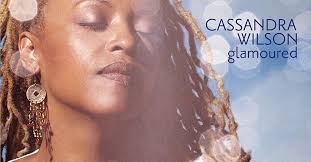 Glamoured – One big recent discovery is Cassandra Wilson’s “Glamoured,” which you should go buy right now (or at least order it online – social distancing and all). Though it likely came from a digital master, it’s been re-released on vinyl as part of Blue Note Records’ Tone Poet reissue series. It’s sparsely arranged, with most tracks featuring just acoustic guitar, upright bass, and some restrained percussion.
Glamoured – One big recent discovery is Cassandra Wilson’s “Glamoured,” which you should go buy right now (or at least order it online – social distancing and all). Though it likely came from a digital master, it’s been re-released on vinyl as part of Blue Note Records’ Tone Poet reissue series. It’s sparsely arranged, with most tracks featuring just acoustic guitar, upright bass, and some restrained percussion.
Wilson’s smoky alto carries the weight of the performance, as she exposes herself emotionally on subjects of regret, love, sex, jealousy and loneliness, as seemingly expressed by a woman contemplating her role in all of them. The music is intimate – sometimes melancholy, sometimes joyous – and utterly engaging. I generally turn my nose up at angst, but this record is expressive and soulful without becoming juvenile, contrived or – heaven forbid – cliché.
If bass is the foundation of music, the footings for this album are poured in 5000 PSI Quikrete. In hi-fi reviewing, bass performance is often discussed as being tight and punchy – it’s ability to suddenly move air in a dramatic fashion. But what sometimes gets overlooked is decay – what happens after that initial punch – when the plucked note is allowed to simply vibrate until it wears itself out. On this record, there’s less fast finger work and more notes simply plucked and left to decay naturally, and that all hangs together to better effect than it does with my own cables.
The rest of the recording is exceptionally well done as well. The acoustic guitars are clearly nylon strung, not wire, and higher pitched drums have slap and distinct signatures. The soundstage is dense, as though the album was befittingly recorded in a small, intimate space. This one’s gotten a lot of play in recent months, and the AQ cables make every bit of it more refined and coherent.
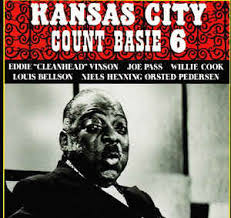 Kansas City 6 – I have closets full of Blue Note, Prestige, and Riverside records, but some of my favorite albums are the small group sessions Count Basie did for Norman Granz’ last label, Pablo Records. Recorded in the late 1970s and early 1980s, they’re mostly blues, jam-ish recordings where everyone gets a chance to show off. It’s not groundbreaking stuff, but it’s still great music, and there are some serious musicians involved. Kansas City 6, for example throws together the Count, Joe Pass, Eddie “Cleanhead” Vinson, Louis Bellson, and Neils Henning Ordsted Pederson. And it swings – sometimes slowly, sometimes hard, but man, does it swing.
Kansas City 6 – I have closets full of Blue Note, Prestige, and Riverside records, but some of my favorite albums are the small group sessions Count Basie did for Norman Granz’ last label, Pablo Records. Recorded in the late 1970s and early 1980s, they’re mostly blues, jam-ish recordings where everyone gets a chance to show off. It’s not groundbreaking stuff, but it’s still great music, and there are some serious musicians involved. Kansas City 6, for example throws together the Count, Joe Pass, Eddie “Cleanhead” Vinson, Louis Bellson, and Neils Henning Ordsted Pederson. And it swings – sometimes slowly, sometimes hard, but man, does it swing.
The other thing about Pablos is they tend to be very well recorded which brings me back to them over and over when I’m reviewing equipment. On KC-6 Bellson’s drums are pushed further back into the soundstage and have extraordinary dynamics while Willie Cook’s trumpet is bright with excellent presence. On “Vegas Drag” Pederson’s bass is enormous, deep and beautifully defined. The Count’s sparse well-placed piano chords have weight and substance in the center-right of the stage. No jazz pianist ever said more with fewer notes than Count Basie.
Everything I love about these Pablo Basie records is enhanced with the AudioQuest cables installed. Horns are a brassier, left-hand piano has more density, and the space is bigger and deeper. The overall clarity is audibly better.
And by the way, the other thing that’s great about Pablo albums is that they’re incredibly inexpensive. I rarely pay more than five bucks for them locally. They’re absolutely one of the few genuine bargains left in vintage vinyl.
Cable Value
 Value is always the most subjective part of any hi-fi purchase. An eight-foot pair of single-wire William Tell ZEROs with spades runs right around $3,000, while the Water interconnects run about $700 for a one-meter pair and $900 for the two-meter version. They’re certainly not inexpensive, but in an era when another well-known company has the audacity to advertise a $50,000 (WTF?!!) pair of speaker cables, the William Tell and Water cables look like comparatively mainstream products, at least by high-end audio standards. If one considers a suite of cables as another component in a similar light with amplifiers, speakers and the like, it may seem more reasonable. Whether or not that’s money you want to spend will always depend on whether you like what they do in your system, and whether you value those qualities enough to open your wallet. At this price point, unlike my review of the AudioQuest Niagara 1200 power conditioner, which at $999 is a stone-cold bargain, I wouldn’t presume to make that judgment for anyone. Having said that, if you are considering a serious upgrade to your wires, and these meet your budget conditions, I would encourage you to put them on your audition list.
Value is always the most subjective part of any hi-fi purchase. An eight-foot pair of single-wire William Tell ZEROs with spades runs right around $3,000, while the Water interconnects run about $700 for a one-meter pair and $900 for the two-meter version. They’re certainly not inexpensive, but in an era when another well-known company has the audacity to advertise a $50,000 (WTF?!!) pair of speaker cables, the William Tell and Water cables look like comparatively mainstream products, at least by high-end audio standards. If one considers a suite of cables as another component in a similar light with amplifiers, speakers and the like, it may seem more reasonable. Whether or not that’s money you want to spend will always depend on whether you like what they do in your system, and whether you value those qualities enough to open your wallet. At this price point, unlike my review of the AudioQuest Niagara 1200 power conditioner, which at $999 is a stone-cold bargain, I wouldn’t presume to make that judgment for anyone. Having said that, if you are considering a serious upgrade to your wires, and these meet your budget conditions, I would encourage you to put them on your audition list.
Conclusion
I’m clear eyed on the fact that the better the system, the more the handing of every interaction between components matters, and that means making an investment in wires. There have been better quality speaker cables and interconnects in my system for a long time now, but I still carry some residual prejudice towards the expense, and I’ve never spent a ton of money on them. This is an old-fashioned attitude, but some folks – myself included – have a hard time thinking of cables as a component unto themselves. An amplifier drives the speakers, a turntable spins records, and a pre-amp controls the action. They do stuff. Wires just sit there, or so they appear. For those of us who grew up in the dark ages of lamp-cord and freebie plastic interconnects – when that was good enough – these are difficult attitudes to overcome.
But even a grump like me has to admit these AudioQuest cables make a worthwhile improvement in the sound of my system. I’ve long since conceded the point: the function of preserving the signal as it passes between components is as important as what the components do with that signal when it arrives. Preserving as much of that signal in its original form is of a singular importance, and the AudioQuest William Tell ZERO speaker cables and Water interconnects succeed in this regard better than any other suite of cables I’ve strung between my components.
An investment in any component is supposed to make your system sound better, and that’s exactly what these AudioQuest cables did for my gear. You can’t argue with better clarity, more detail, improved sound-staging, and more thoroughly defined bass. The cables focused my system in ways I’d not experienced before, allowing a more highly resolved, less granular presentation of the music to shine through. My system sounded good before. It sounds better now.
The AudioQuest William Tell ZERO speaker cables and Water interconnects did exactly what anyone would want from an improved set of cables. They made my music sound better.
A Final Plug for A Local Folk Hero
This is a real long shot, but if AudioQuest is contemplating expanding their “Folk Heroes” line of cables, I’d like to toss a local Pittsburgh legend into the ring for consideration: Joe Magarac, the legendary hero of steel workers everywhere. A twenty-foot tall statue of Joe still stands at the gates of U.S. Steel’s Edgar Thomson works in Braddock, PA, protecting the men as they cast ten-ton slabs in Dickensian conditions. Born on a mountain of iron ore and made of solid living steel, Magarac was said to have single handedly rescued a shed full of dues-paying union workers by catching a falling fifty-ton crucible full of molten metal with his bare hands. And while every super-hero needs a secret hideout, forget about any fancy Bat Caves or Fortresses of Solitude – Magarac lived at Mrs. Horkey’s rooming house down in Braddock. I haven’t seen it referenced anywhere, but if anything could possibly have injured this guy it’s all but certain he would have bled Black & Gold.
So why not? Joe Magarac makes as much sense as naming cables for a Swiss marksman who assassinated a tyrant. Though I must admit, William Tell does have a better overture.


greg simmons
Specifications:
AudioQuest Water Interconnects
$699.95 one-meter pair
$899.95 two-meter pair
AudioQuest William Tell ZERO Speaker Cables
$2,990.00 8’ pair, single wire spades
Specifications:
William Tell ZERO Speaker Cables
ZERO technology (proprietary)
Ground Noise Dissipation
Solid Perfect Surface Copper Plus conductors (PSC+)
Carbon-Based Linearized Noise Dissipation System (NDS)
72V Dielectric Bias System (DBS) with Carbon Level RFI Traps
Cold-Welded Terminations
Directional Cable
Water Interconnects
Solid Perfect Surface Copper Plus conductors (PSC+)
Polyethylene Air Tube Insullation
Triple Balance Geometry (separate ground reference conductor)
Carbon based six layer Noise Dissipation System (NDS)
Cold welded, hanging silver plating over high purity re-copper lugs
Dielectric Bias System (DBS) with radio frequency trap
Directional Cable
Greg’s Associated Equipment:
Analog Front End
SOTA Sapphire turntable
Rek-O-Kut T12h turntable
Technics 1200 Mk 1 turntable
Technics 1200 M3G turntable (Stock Arm)
Jelco 9” SA-750 DB toneam (SOTA)
AudioQuest PT-6 tonearm (Tech-12 Mk I)
Karmadon 12” viscous damped unipivot tonearm (Rek-O-Kut)
Lyra Delos cartridge
Audio-Technica OC/9-III cartridge
Audio-Technica AT33Sa cartridge
Miyajima Spirit Mono cartridge
Digital Front End
Cambridge CXC CD transport
Cambridge 840C CD player (still collecting dust)
Amplification
Cary SLP-98P preamp w/ phono stage
Cary CAD 280 SA V12R power amplifier
Aurorasound SP-03H step-up transformer
Lyric Audio PS-10 MC/MM phono stage
Loudspeakers
Verity Audio Fidelity Encore
Cabling
AudioQuest Copperhead Interconnects
AudioQuest William Tell ZERO speaker cables
AudioQuest Water Interconnects
Zentara Reference ICs
Zentara Reference Speaker Cables
Nordost Blue Heaven ICs
Cullen power cables
AudioQuest NRG-Z3 power cables
MIT Z-Cable power cords
Accessories
AudioQuest Niagara 1200 power conditioner
Tice Box power conditioner
Nordost Sort Kones AC vibration dampers
Mapleshade Audio Rack
Jim Beam Quarantine Coping Crutch
Stereo Times Masthead
Publisher/Founder
Clement Perry
Editor
Dave Thomas
Senior Editors
Frank Alles, Mike Girardi, Key Kim, Russell Lichter, Terry London, Moreno Mitchell, Paul Szabady, Bill Wells, Mike Wright, Stephen Yan, and Rob Dockery
Current Contributors
David Abramson, Tim Barrall, Dave Allison, Ron Cook, Lewis Dardick, Dan Secula, Don Shaulis, Greg Simmons, Eric Teh, Greg Voth, Richard Willie, Ed Van Winkle, and Rob Dockery
Music Reviewers:
Carlos Sanchez, John Jonczyk, John Sprung and Russell Lichter
Site Management Clement Perry
Ad Designer: Martin Perry






Be the first to comment on: AudioQuest William Tell ZERO Speaker Cables and Water Interconnects by Greg Simmons